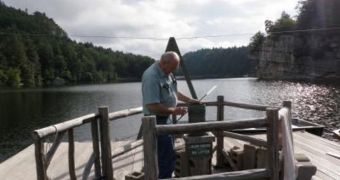Analyzing long-term weather trends in a single region is usually a tricky business. As the decades go by, numerous changes take place, and the stations are dismantled, moved to make way for new developments, or are shut down for ever. At other locations, readings are only taken once a week or once a month, and so the data is fairly stretched out over the year. But there is one place in the United States where climate readings have been taken each and every single day, for the last 114 years.
About 90 miles north of New York City lies The Mohonk Preserve. Inside it, a special spot has been visited each day since January 1, 1896 by a hiker. The resort and nature area has had its daily temperatures and other climate conditions measured constantly, and not a single day is missing from the records. The consistency of the analysis has not been hindered by two full-blown world wars, or by the Cold War, in addition to other factors. The landscape too has remained the same, as have the location of the lookout point and every other factor that may have varied with time.
In charge of this effort is a single family, which is occasionally assisted by friends. This ensures that the same methods for collecting the data are used. This means all changes found in the records actually take place in nature, and are not the result of the data-collection process. The story of the Smileys, the Quaker family that took reigns of the Mohonk weather station since it was first created, appears in the latest issue of the esteemed scientific Journal of Applied Meteorology and Climatology. It was published by experts at the Columbia University Lamont-Doherty Earth Observatory. One interesting thing to note here is that a large number of the initial instruments provided by the former United States Weather Bureau (later the National Weather Service) are still fully-functional at the station.
Mohonk staffers have spent the last 20 years transforming the paper log sheets into digital versions of themselves. This will help them introduce the information in computer models that will be able to extract long-term patterns and create predictions. “It is incredibly rare to have the level of continuity that we have at Mohonk. Any one record cannot tell you anything definitively about climate globally or even regionally. But looking closely at sites like this can boost our confidence in the general trends that we see elsewhere, and in other records,” explains Lamont climate modeler Benjamin Cook.
“Pictures, anecdotes, and cursory glances of poorly sited or maintained sites and weather stations may suggest problems, but until the data is analyzed it is impossible to conclude that the record is compromised by cold or warm biases," said Cook. "The advantage to Mohonk is that we can revisit the record in detail, with minimal corrections. This helps confirm the large-scale trends, and it helps us identify stations with errors that need to be corrected. We and the Smileys all just happened to be in the right place, at the right time,” he concludes, quoted by ScienceDaily.

 14 DAY TRIAL //
14 DAY TRIAL //